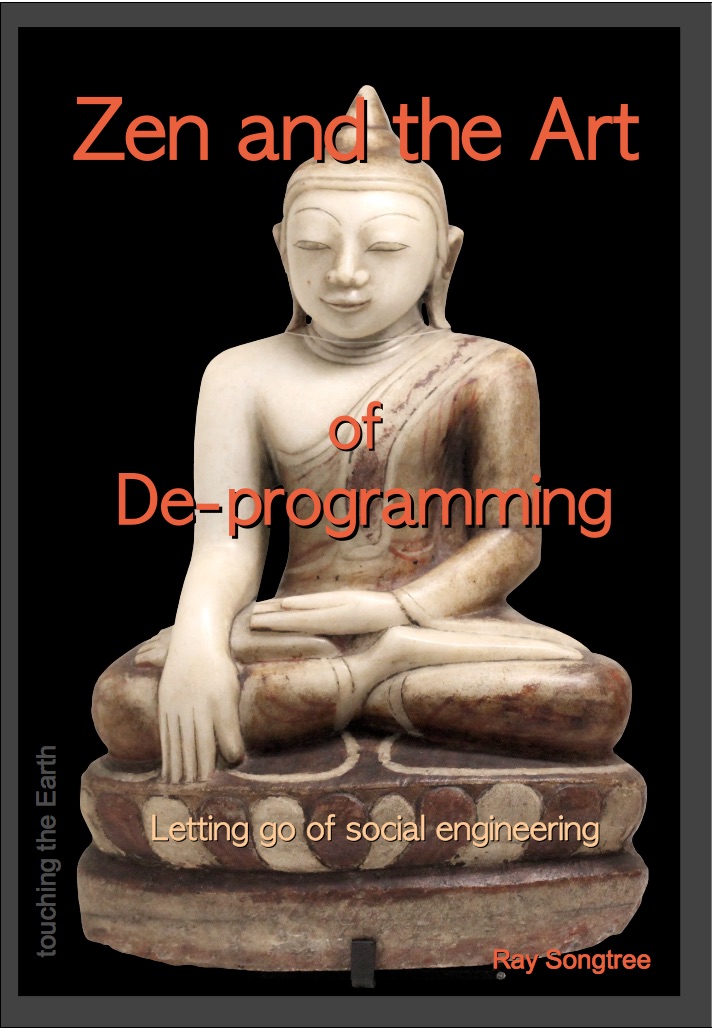Ray
On 9/20/2017 at 1:52 PM, “N> wrote:
Yes there are scientists who’ve been paid off by the deep state & secret gov’t who put bogus information out there, but that doesn’t negate the field of science.
I know too many scientists to support what you say about that; they are brilliant, see deeper into things that we can’t see, put it all together, want the best for the planet and people as much as we do. – N
Ray wrote –
When you say “the planet and people”, this is contradictory. At this point “people” means the dominant culture. Most people think humans can represent Earth. This needs to be seen from Earth’s perspective. From Earth and millions of species’ perspective, no industrial human could speak for her.
In contrast to what “scientists” want, I want what is best for millions of other species.
Millions of other species need this civilization to go away, otherwise, they will die. We should all contribute to this happening as soon as possible.
Homo indoorsians ignore that humans have destroyed most wild habitats. This civilization doesn’t care. For example, most people don’t care that unknown number of species of plankton in the oceans are dying.
Ocean life is dying in mass, and no one knows why – We Are Change
The ocean is dying, by all accounts … Ocean life is dying in mass, and no one knows why ? … Sockeye Salmon 1 0) Herring 11) plankton 12) Anchovies (again) …
Study: Dead sea creatures cover 98 percent of ocean floor off …
The Food Chain’s Weak Link: Tiny Ocean Plants Dying : NPR
Microscopic plants in the ocean, called phytoplankton, are among the most important creatures on Earth and produce half of the planet’s oxygen. ]
I think that the reason I sound like a “know it all” is that I put forth strong statements that go against the grain of the dominant culture. I simply state ecologic imperatives as absolute truths. This makes me sound like a know it all, but I am just stating obvious absolute truths which are not my opinion, they are nature. If I say pollution is not sustainable, this is very obvious, yet most people think pollution is part of “progress,” so get used to it. By stating the opposite imperatively and not qualifying my sentences with humble conditionality, I’m sorry if I sound dogmatic. I am just stating facts. What goes up must come down. It is not an opinion. Or should I say, “I don’t think it is an opinion in my limited estimate.”
I’m not a know it all. I just tend to list evidence like I am writing a legal brief.
We are discussing science itself, and yes we can and should negate the entire field of science. The faster science can go away, the faster survival for all will come back to planet.
Science has proven itself, for many centuries, as incapable of being honest, because it cannot question it’s own raison d’êtr (reason to exist). Science is thus fundamentally deluded. It’s reason to exist is never to honor nature, but to twist nature into new shapes and to deny any suffering caused by the experiment. This is the raison d’êtr of science. Science does not accept nature, science wants to do better than nature. This vain “pursuit of knowledge” justifies any abuse. We have to get “to the stars” after all! I won’t get into the ET connection here but see link.
We cannot define science without noticing it’s impact. It would be irresponsible to do so. Here is my definition…
The field of science is the temporary and unsustainable desire to divide and conquer nature for a Homo indoorsian, artificial, alien agenda.
I’ve not stated the “ideals” of science, I have stated its impact and the only impact it can have. Other definitions will state the ideal “pure” intentions of science, without addressing the history or impact. These other definitions are basically propaganda. The impact is the real deal and it is a dying planet.
science (sīˈəns)
-
n. The observation, identification, description, experimental investigation, and theoretical explanation of phenomena.
-
n. Such activities restricted to a class of natural phenomena.
-
n. Such activities applied to an object of inquiry or study.
Hold on! Who funds science? What is the self interest of research? How are distortions in a laboratory then applied in real world?
The impact is the real deal and it is a dying planet. This is not normal. Outside of the bubble of this civilization’s mentality, there is a sane world. It is easy to find. Just ask, “What existed before the impact?”
The alternative to divide and conquer is what existed in the Americas before 1492.
In my opinion, true value is what is best for as many beings, human and non human, as possible. When we support the wide health, we are compassionate. When we ignore the wide health, we are agents of destruction. To determine true value let’s ask, “Which is sustainable? Divide and conquer or nature?”
Let’s ask… Has science ever improved anything except faster destruction?
How about health? Example.. has modern medicine made the human gene pool stronger or weaker? Please answer this question in you own mind before reading on…
The murky future of the human gene pool – ScienceBits
Please think about this….
When experiments are extended to outside of the laboratory, the result is always, 100% of time, destruction.
And even more fundamentally, all science, 100%, so I do mean all, depends on mining and polluting. This is never justifiable for any reason.
Therefore, our stone age lifetimes were more advanced morally than our present “modern” incarnations. The proof is that those cultures did not destroy the Earth. What other proof is needed? (Am I interrupting anyone’s latte?)
The vain dominant culture calls morally advanced cultures “primitive”. Our language is doublespeak. What we call “progress,” the Earth calls destruction. What we say is “advanced” is in reality, criminal. Also note how people put their noses in air about others being “primitive.”

Is Mother Nature a petri dish? Who would answer “Yes”? Well, scientists do. 
The choice that makes normal intelligent people become insane is buying into “divide and conquer” as justifiable, because their vanity thinks nature can be improved upon.
It cannot. Nature is billions of years of trial and error. Humans can’t beat that, they can just distort it for temporary gain. ET can distort it for their temporary joy rides too. Their voyeur way is not sustainable because they destroy nature.
But scientists experiment and in the short term, offer fixes, which in the long term weaken, replace, and destroy nature. The evidence is what is happening. It is not my opinion, it is what is happening. See, I sound haughty because I am going against grain using what is happening, which is demonstratively real and true. I don’t think the Earth is dogmatic, and in defending her, neither am I. But I guess I sound like it.
Can we agree that if sanity is not moral, it is not sanity?
Does “moral” include “respect.” Respect means hands off. Others have sovereignty and I respect that and give them space. This includes other species, not just mine.
In my opinion, a moral scientist would get a new job… He or she would realize that it is insane to try to re-invent nature and destroy the habitat of countless other beings in the process.
The next are not meant as rhetorical questions. They are questions to be pondered when you have the time.
- Ask yourself, will humans be stronger and more sovereign when we go back to oral tradition without any symbols, including written languages, as most tribes practiced for tens of thousands of years? Yes, that is my drift… no more reading or writing, no more mind programming religions, no more leaving the now. We have ten fingers which is enough, and speech. Written language was invented as a management tool. It was for the elite who had time to learn it because they had slaves, and it was kept secret from the slaves. Written language was a secret code for the privileged. Now it is used for distraction. Most books at library are fiction thrillers. The Hawaiians were here in Hawaii without written language for a thousand years and didn’t pollute it. We have polluted Hawaii in just the last 100 years. So which civilization was superior, stone age or smart phones?
- Have graven images ever made any person more clear?
- Has literacy ever made anyone morally wise?
- Has mathematics ever helped anyone see anything holistically?
But scientists think they can replace nature with something better! Their vanity tells them that collateral damage is okay because humans have “dominion over nature.”
And so we get back to Satanism, which is what Moses channeled. “In the beginning was mind programming.” This civilization is run by satanists and has been for 7000 years. The proof is in what it has accomplished… Temporary obesity at the expense of all future generations.
Does that sound judgmental? What is wrong with that?
Ray
PS… A person can’t understand what I am saying if they stay in this civilization’s box. Imagine being Ishi and viewing this civilization. Please imagine how every indigenous culture in this world views this dominant civilization.
Now that you have done that, now, what do you think of scientists?????
Ishi, The Last Undomesticated (wild, natural, ancient) Native American
 In 1865,[2] Ishi and his family were attacked in the Three Knolls Massacre, in which 40 of their tribesmen were killed. Although 33 Yahi survived to escape, cattlemen killed about half of the survivors. The last survivors, including Ishi and his family, went into hiding for the next 44 years, and their tribe was popularly believed to be extinct.[3] Prior to the California Gold Rush of 1848–1855, the Yahi population numbered 404 in California, but the total Yana numbered 2,997.[4]
In 1865,[2] Ishi and his family were attacked in the Three Knolls Massacre, in which 40 of their tribesmen were killed. Although 33 Yahi survived to escape, cattlemen killed about half of the survivors. The last survivors, including Ishi and his family, went into hiding for the next 44 years, and their tribe was popularly believed to be extinct.[3] Prior to the California Gold Rush of 1848–1855, the Yahi population numbered 404 in California, but the total Yana numbered 2,997.[4]
The gold rush brought tens of thousands of miners and settlers to northern California, putting pressure on native populations. Gold mining damaged water supplies and killed fish; the deer left the area. The settlers brought new diseases such as smallpox and measles.[5] The northern Yana group became extinct and the central and southern groups and Yahi populations dropped dramatically. Searching for food, they came into conflict with settlers, leading to bounties on the natives by the settlers. Prices included 50 cents per scalp and 5 dollars per head. In 1865, the massacre began while the Yahi slept in bed.[citation needed]
Richard Burrill wrote, in Ishi Rediscovered: “In 1865, near the Yahi’s special place, Black Rock, the waters of Mill Creek turned red at the Three Knolls Massacre. ‘Sixteen’ or ‘seventeen’ Indian fighters killed about forty Yahi, as part of a retaliatory attack for two white women and a man killed at the Workman’s household on Lower Concow Creek near Oroville. Eleven of the Indian fighters that day were Robert A. Anderson, Hiram Good, Sim Moak, Hardy Thomasson, Jack Houser, Henry Curtis, his brother Frank Curtis, as well as Tom Gore, Bill Matthews, and William Merithew. W. J. Seagraves visited the site, too, but some time after the battle had been fought.”
Burrill continued, “Robert Anderson wrote, ‘Into the stream they leaped, but few got out alive. Instead many dead bodies floated down the rapid current.’ One captive Indian woman named Mariah from Big Meadows (Lake Almanor today), was one of those who did escape. The Three Knolls battle is also described in Theodora Kroeber’s Ishi in Two Worlds, but more information has come to light. It is estimated that with this massacre, Ishi’s entire cultural group, the Yana/Yahi, may have been reduced to about sixty individuals. From 1859 to 1911, Ishi’s remote band became more and more infiltrated by non-Yahi Indian representatives, such as Wintun, Nomlaki and Pit River individuals.
In 1879, the infamous Indian boarding schools started in California. The ranks of embittered reservation renegades who became the new “boys in the hills”, to quote Robert Anderson, became a direct function of what new attacks or removal campaigns that the volunteers and military troops elected to carry out against the northern California Indian tribes during that time.”
In late 1908, a group of surveyors came across the camp inhabited by two men, a middle-aged woman, and an elderly woman—Ishi, his uncle, his younger sister, and his mother, respectively. The former three fled while the latter hid herself in blankets to avoid detection, as she was sick and unable to flee. The surveyors ransacked the camp [because this civilization respects nothing] and Ishi’s mother died soon after his return. His sister and uncle never returned.
After the attack, Ishi spent three more years in the wilderness, alone. Finally, starving and with nowhere to go, at around the age of 50 on August 29, 1911, Ishi walked out into the western world.[3] He was captured attempting to forage for meat near Oroville, California, after forest fires in the area.[6]
“After the native was noticed by townspeople, the local sheriff took the man into custody for his own protection”. The “wild man” caught the imagination and attention of thousands of onlookers and curiosity seekers. Professors at the University of California, Berkeley, Museum of Anthropology—now the Phoebe A. Hearst Museum of Anthropology (PAHMA)—read about him and brought him to their facility,[6] then housed on the University of California, San Francisco campus in an old law school building. Studied by the university, Ishi also worked with them as a research assistant and lived in an apartment at the museum for most of the remaining five years of his life. In June 1915, he temporarily lived in Berkeley with the anthropologist Thomas Talbot Waterman and his family.[7]
Ishi revealing Yahi culture
Waterman and Alfred L. Kroeber, director of the museum, studied Ishi closely over the years and interviewed him at length to help them reconstruct Yahi culture. He described family units, naming patterns, and the ceremonies that he knew, but much tradition had been lost because there were few older survivors in the group in which he was raised. He identified material items and showed the techniques by which they were made. Ishi provided valuable information on his native Yana language, which was recorded and studied by the linguistEdward Sapir, who had previously done work on the northern dialects.
Illness and death
Ishi, having come to live in San Francisco and lacking immunity to the “diseases of civilization“, was often ill. He was treated by a Professor of Medicine at UCSF, Saxton T. Pope. Pope became close friends with Ishi, and learned from him how to make bows and arrows in the Yahi way. He and Ishi often hunted together.
Ishi died of tuberculosis on March 25, 1916. His friends at the university initially had tried to prevent an autopsy on Ishi’s body since the body was to be kept intact according to Yahi tradition, but the doctors [fucking scientists] at the University of California medical school performed one before Waterman was able to stop it. Ishi’s brain was preserved [by immoral insane scientists] and the body cremated.
Included alongside his remains were “one of his bows, five arrows, a basket of acorn meal, a boxful of shell bead money, a purse full of tobacco, three rings, and some obsidian flakes.” Ishi’s remains were interred at Mount Olivet Cemetery in Colma, near San Francisco,[8] but his brain was put in a deerskin-wrapped Pueblo Indian pottery jar and sent to the Smithsonian Institution by Kroeber in 1917, where it remained until August 10, 2000, when descendants of the Redding Rancheria and Pit River tribes received the brain, according to both the letter and the spirit of the National Museum of the American Indian Act of 1989 (NMAI).[9]
According to Robert Fri, director of the National Museum of Natural History, “Contrary to commonly-held belief, Ishi was not the last of his kind. In carrying out the repatriation process we learned that as a Yahi–Yana Indian his closest living descendants are the Yana people of northern California.”[10] Once the brain and remains were returned, further information about them has remained private.[9]






Ray:
Really interesting stuff you have to say. Four things.
1. People and mankind are part of nature, for better or worse.
2. Nature can also mess with its ecological balances. Algae can overtake a pond or lake, cut off the oxygen supply and kill other living things in the pond. Nature does not care because algae is part of nature. Everything that happens in the world is part of nature.
3. Perhaps people have the chance to reverse climate change and CO2 production, but they are going to have to change the economic structures in their countries. Capitalism is based on maximizing profit by minimizing and externalizing costs. Working people have known about this for a long time in terms of low wages. So, efforts to minimize damage by human technology treated as a secondary problem (fossil fuels, plastics, etc.) and not to be paid for if possible. Sometimes corporations try a bit, but the effort is still minimal. Fracking = not good.
4. So, can capitalist countries reverse their current practices. I hope so, but the people must dispense with capitalism as part of the process of minimizing damage to the environment. But our numbers have reached 7 billion +. Even with good intentions, we algae may not be able to stop cutting off oxygen to the pond.
Nothing new here really, but this is the biggest problem. How to produce basic necessities while minimizing damage to the current balance of nature.
I am interested in the way you think, but I think you have to bring in the economic system that we are immersed in.
My two cents.